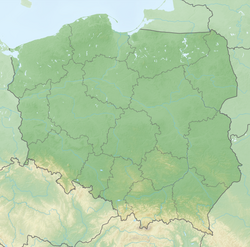Truso
|
|
This article or section was due to content flaws on the quality assurance side of the Germanic project entered. This is done in order to bring the quality of the articles from this topic to an acceptable level. Please help to fix the shortcomings in this article and join the discussion ! |
Coordinates: 54 ° 4 ′ 0 ″ N , 19 ° 27 ′ 0 ″ E
| Viking Age trading post Truso | ||
|---|---|---|
| location | Warmia-Masuria , Poland | |
| Location | near Elbing | |
|
|
||
| When | Viking age | |
| Where | near Elbing , Warmia-Masuria | |
| displayed | Finds are kept in the Elbinger Museum. | |
|
A reconstructed house from Truso (Museum in Elbląg) |
||
Truso , also known as the Atlantis of the North , was an old Prussian town in the Vistula delta on the Frischen Haff or the Baltic Sea in the 9th century . It was not far from the point at which the Nogat arm of the Vistula flowed into a bay in the Fresh Lagoon. This bay corresponds to today's Drausensee (Polish Druzno, Prussian Drusin), which was separated from the lagoon by silting up.
The name of this bay was later transferred to the resulting lake and to the Druso trading center ("Truso" in Wulfstan's pronunciation ). Around 890, Wulfstan, as he himself reports, undertook a boat trip to Truso in the service of King Alfred the Great from Haithabu (in what is now northern Schleswig-Holstein near Schleswig ). At that time the Vikings, especially Danes and Norwegians, had conquered almost all of England.
Truso was conveniently located on a trade route that led from Birka in the north via Visby on the island of Gotland in the Baltic Sea to Truso or the later Hanseatic city of Elbing . From there the traders moved on to Carnuntum on the Danube. This old amber road led bypassing the Eastern Alps to the Mediterranean . The east-west trade took place from Truso along the Baltic Sea to Jutland and further inland to Haithabu, which was one of the largest trading centers at the time.
In 1897 a large area with archaeological finds was discovered near Gut Hansdorf, and excavations were carried out in the 1920s. A large burial ground was also found near Elbing. The finds came to the Elbinger Museum. Further excavations could not be continued because of the war.
Several places in the vicinity of Elbing testify to the name, such as Neuendorf, which was called Deutsch-Druze until the beginning of the 15th century, and Drusenhof between Elbing and Prussian Holland.
In 1945 the area came under Polish administration. Resumed excavations in the 1990s have shown that Truso, like other trading places, had a multiethnic character and goods from the Prussians (called Aestii Gothic Aesti in Latin sources), Scandinavians , Slavs and Frisians were exchanged, and articles were made in workshops.
A thick layer of fire and arrowheads suggest that the city was destroyed by pirates. The area is about 20 hectares with two types of buildings, one with the dimensions 5 × 10 meters and on the other hand long houses with about 6 × 21 meters.
The meaning of the name of the Prussian trading place Truso probably goes back to the idg. Root "dreu- / dru-": expire, hurry back; On the other hand, one can recognize in Old Saxon, as in Middle English trussen , English truss , which means something like bundle together, enclose, support in the construction, i.e. a commercial residence, and in the sound shift like Duer to door, gate, Düringer to Thuringian. A derivation from Prussian “truszas, tružas”: reed, cane is also possible.
Footnotes
literature
- Marek F. Jagodziński: Truso. In: Reallexikon der Germanischen Altertumskunde (RGA). 2nd Edition. Volume 31, Walter de Gruyter, Berlin / New York 2006, ISBN 3-11-018386-2 , pp. 291-295.
- Maria Biolik: tributaries to the Baltic Sea between the lower Vistula and Pregel = Nazwy wodne dopływów Bałtyku między dolną Wisłą a Pregołą (= Hydronymia Europaea. Lfg. 5). Steiner-Verlag Wiesbaden, Stuttgart 1989, ISBN 3-515-05521-5 .
- Wilhelm Gaerte : Prehistory of East Prussia (= East Prussian regional studies in individual representations. Bd. 1, ZDB -ID 2270555-7 ). Gräfe and Unzer, Königsberg 1929.
- Georg Gerullis : The old Prussian place names collected and linguistically treated. Association of Scientific Publishers, Berlin a. a. 1922.

